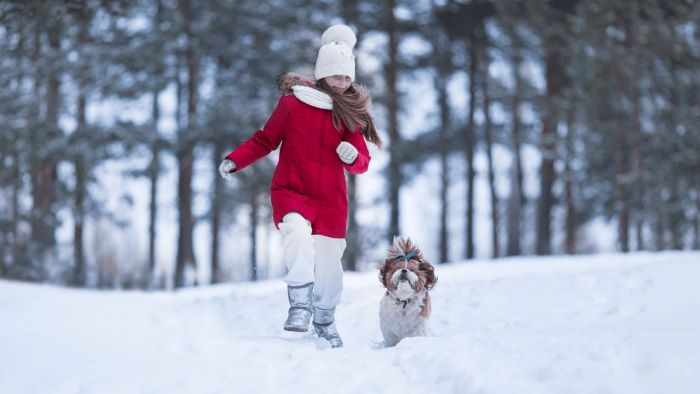Winter can be a wonderful time of the year, especially if you love spending time outdoors with your dog. There are so many fun activities you can do together such as sledging, snowshoeing or building a snowman. Your dog may even enjoy catching snowballs or digging in the snow.
However, winter also brings some challenges and dangers for your dog. The cold temperatures can affect their body temperature. You might wonder when is it too cold to walk your dog. Well, the answer depends on several factors, such as your dog’s size, coat, age, and health status.

Let us explore how to determine when is it too cold for your dog to walk and how to protect them from the risks of frostbite and hypothermia.
When Is It Too Cold to Walk Your Dog?
Countries like the UK have relatively mild winters. The season is generally cool, wet, windy, and cloudy. Temperatures at night rarely drop below −10 °C (14 °F) and in the day rarely rise above 15 °C (59 °F).[1] As the mercury falls, you try wrapping yourself under wool bundles to keep yourself warm. However, have you ever thought of your Fido?
Your dog needs outdoor walks to maintain regular exercise and frequent potty breaks. But, how much temperature can a dog tolerate? When is it too cold to walk your dog? Many dogs can tolerate temperatures up to -7℃ whereas some others fall sick even at 7℃. The temperature tolerance in dogs depends on their age, breed and any underlying medical condition like obesity.

As a thumb rule, you should not take your short-haired or hairless dog for a walk below -4℃ and your long-coated dog below -9℃. No dog should be taken out for a walk if the weather drops below -9°C, as they will be unable to withstand such cold temperatures.
Factors That Can Influence Cold Weather Walks
Many dogs can withstand cold temperatures as they are habitat to polar regions or other cold regions like the huskies whereas a slender breed, bred for warmer climates can shiver at just a slight mercury fall. Similarly, various factors affect the cold tolerance of dogs.
1) Breed
Some breeds not only tolerate the cold weather but also enjoy the wintery now. Breeds such as Siberian Huskies, German Shepherds and Newfoundlands can easily tackle cold. However, some breeds are vulnerable to cold weather.
Dogs with these features suffer the most in winter:
- A slender breed, bred for warmer climates
- Dogs with short coats
- Hairless breeds
- Dogs with short noses
- Puppies and senior dogs
- Dogs with underlying health conditions
These breeds are Great Dane, Poodles, Pug, Chihuahua, French Bulldog and Greyhound.
Some breeds like Huskies and Newfoundlands tolerate the cold weather but may struggle in hot weather. It’s important to know when is it too hot to walk your dog depending on their breed
2) Size
Even large dogs with short hair coats suffer from cold. Therefore, there is never a general rule for the size of a dog. However, on a note almost all small dogs will struggle to cope with extreme temperature and hence small walks is enough for them.
Greyhounds and Great Danes are both larger breeds, but they have short coats and relatively little body fat, which means they are not very well insulated from the cold.
3) Age
Young puppies are prone to cold as they do not know how to handle the temperature change. Also, they are in their development stage and little do they understand the body cycle. On the other hand, senior dogs can have trouble regulating their body temperatures and may have health issues that are exacerbated by the cold, like joint aches.
Thus, small puppies as well as older dogs, regardless of their breed cannot be left outside unattended. They naturally struggle to regulate their body temperature and need a coat to keep themselves warm even at the slightest temperature drop.
4) Health Condition
Cold weather can be especially problematic for dogs who suffer from stiff joints. The low temperatures can cause muscles to tighten up and increase pressure when they are walking. In such cases, always ensure to provide warmth to your dog.
Dogs with health conditions may also not have the energy or the willpower to go out into an unpleasant environment if they’re feeling under the weather. Certain larger breed dogs are prone to problems like hip dysplasia and cold weather can exacerbate the pain.
Should My Dog Wear a Coat for Walks?
Just as you wrap up your best winter coats to cut the chilly winters, you might have thought of wearing your dog a coat too. But, do dogs need a coat? Generally, dogs can withstand normal temperatures during winter. However, if the temperature drops and it’s adversely cold then some dogs might need to wear a winter coat.

When the temperature drops below zero degrees Celsius, your small pooch should walk out of the house with a coat on. Large dog breeds with long hair coats can tolerate cold as they have a thick layer of insulation. These dogs do not require coats even at -5°C.
If a dog spends a short period in the snowy winters say, 10-15 minutes, he does not require a coat as such weather won’t affect the dog. But, you should not expose your dog to harsh colds for a longer time. A short distance walk is enough to keep your pup healthy. You can also increase the frequency of walks instead of taking one long walk.
Make sure to bundle up yourself as well with warm layers, boots, and the best dog walking gloves to protect your hands
Signs Your Dog is Too Cold
Just like we show signs and symptoms of cold, dogs too show signs. You should look for these signs to know whether your Fido can go out for a walk or not. Your dog needs care and attention from you during cold weather.[2] Ignorance of these signs can lead to frostbite in dogs and it might worsen the condition.
Signs that your dog is too cold:
- Trembling or shivering
- Very cold ears
- Whimpering
- Hunched back and tucked in tail
- Anxious behaviour and unwillingness to continue walking
- Limp or stiff movement
- Lifting paws off the ground
If you notice these signs during a walk, it’s best to head back home. Consider reducing the length of walks in cold weather and watching for signs of your dog getting too cold. Be mindful of how long should I walk my dog when temperatures drop.
“Dogs with underlying diseases, such as diabetes mellitus, can have impaired circulation, making them more likely to develop frostbite. Very young dogs cannot regulate their own body temperature effectively, so they are also at increased risk.“, confirms Kelly Sulik at petMD.
Frostbite and hypothermia are serious conditions that can affect your dog in cold weather. Frostbite occurs when the blood vessels in the skin constrict and reduce blood flow to the extremities, such as the ears, paws and tail.

To prevent frostbite and hypothermia in your dog, you should follow these tips:
- Dogs should not be left outside for extended periods of time when the weather is very cold.
- Dog clothes such as sweaters and boots may help keep dogs warm for short periods of time, but should not be used as a substitute for keeping dogs indoors.
- Wipe down your dog’s paws after they come inside and check for signs of frostbite or injury. Frostbite can affect their ears, tail and feet, and it may look like white or blue skin.
- Provide your dog with a warm and cosy shelter, either indoors or outdoors. Make sure to insulate their shelter and keep it dry and clean.
- Monitor the weather conditions and your dog’s behaviour before and during your outdoor activities. If you notice any signs of hypothermia bring your dog inside and contact your veterinarian.
FAQs
At what temperature do dogs get cold?
Some cold-averse dogs might begin to feel uncomfortable below 10℃. Owners of smaller breed dogs, dogs with short or thin coats, and/or very young, senior dogs, dogs with health conditions, or sick dogs should pay close attention to their pet’s well-being below 0°C.
Should I walk my dog in the cold and rain?
As long as your dog is not exposed to wet, cold weather for too long, and is dried off when you get home, they won’t be affected by the cold. It’s much more dangerous to walk your dog in hot weather than in the cold or rain.
How do I keep my dog warm on winter walks?
Look for a coat specifically for dogs that fit properly. Those made from warm materials such as wool or fleece are great and can benefit from a waterproof outer layer helping in ice or snow. If you’re heading out take care around grit or salt as this can burn your dog’s paws.
How do I know if my dog is cold?
Check for signs of shaking or shivering. The dog might also start whining or barking when taken out for a walk. Other signs include a change in behaviour and lifting the paws off the ground.
Final Thought
Walking your dog in the cold weather can be a fun and rewarding experience, as long as you take the necessary precautions to keep them warm and comfortable. By taking some precautions, you can ensure that your dog stays healthy and happy during the winter months.
Remember to always monitor your dog for signs of cold stress and consult with a veterinarian if you have any concerns. When in doubt, use the general rule: if it’s too cold for you, it’s likely too cold for your dog, too. Happy Winters!❄🐶
References:
- Wikipedia contributors. (2023b). Climate of the United Kingdom. Wikipedia.
- Shmerling, R. H., MD. (2018). 10 things you can do for your pet when it’s cold outside from Harvard Health.



